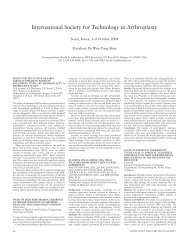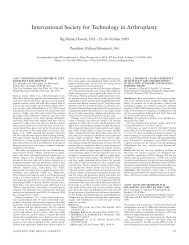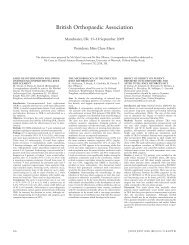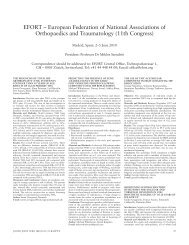Procs III 2011.indb - Journal of Bone & Joint Surgery, British Volume ...
Procs III 2011.indb - Journal of Bone & Joint Surgery, British Volume ...
Procs III 2011.indb - Journal of Bone & Joint Surgery, British Volume ...
You also want an ePaper? Increase the reach of your titles
YUMPU automatically turns print PDFs into web optimized ePapers that Google loves.
354 HELLENIC ASSOCIATION OF ORTHOPAEDIC SURGERY AND TRAUMATOLOGY<br />
090 BILATERAL SIMULTANEOUS TOTAL HIP<br />
ARTHROPLASTY: SAFETY AND EFFICACY<br />
– A META-ANALYSIS<br />
E. Tsiridis, I. Pagkalos, I. Polyzois, G. Pavlou, J.<br />
Charity, E. T i h , G. Gie, R. West<br />
Academic Department <strong>of</strong> Trauma and<br />
Orthopaedics, Leeds General Infirmary; Leeds<br />
School <strong>of</strong> Medicine, Leeds University, LS1 3EX<br />
Leeds, UK; Princess Elizabeth Orthopaedic<br />
Centre, Hip Unit, Royal Devon and Exeter<br />
Hospital, EX2 5DS Exeter, UK; Institute <strong>of</strong><br />
Health Sciences, Centre for Epidemiology and<br />
Biostatistics, Leeds University, LS1 3EX Leeds,<br />
UK; Cardio-Thoracic Anaesthetic Unit, “Blue<br />
Cross” Hospital, Thessaloniki, Greece.<br />
Comparison <strong>of</strong> the safety and effi cacy <strong>of</strong> Bilateral Simultaneous<br />
Total Hip Arthroplasty (BSTHA) with that <strong>of</strong><br />
staged (SgTHA) and unilateral (UTHA) was conducted<br />
using DerSimonian–Laird heterogeneity meta-analysis.<br />
A review <strong>of</strong> the English-language literature identifi ed<br />
23 citations eligible for inclusion. A total <strong>of</strong> 2063 bilateral<br />
simultaneous THR patients were identifi ed. Metaanalysis<br />
<strong>of</strong> homogenous data revealed that there were<br />
no statistically signifi cant differences between rates <strong>of</strong><br />
thromboembolic events (p=0.268 and p=0.365) and<br />
dislocation (p=0.877) when comparing staged or unilateral<br />
with bilateral simultaneous THR procedures. A<br />
systematic analysis <strong>of</strong> heterogenous data demonstrated<br />
that mean length <strong>of</strong> hospital stay was shorter after bilateral<br />
simultaneous THR. Blood loss was reduced after<br />
bilateral simultaneous THR in all studies except for one,<br />
and surgical time was not different between groups.<br />
This procedure was also found to be economically and<br />
functionally effi cacious when performed by experienced<br />
surgeons in specialist centres.<br />
091 CEMENT-IN-CEMENT STEM REVISION<br />
FOR VANCOUVER TYPE B PERIPROSTHETIC<br />
FEMORAL FRACTURES AFTER TOTAL HIP<br />
ARTHROPLASTY: 3 YEAR FOLLOW UP OF 24<br />
CASES<br />
T.W. Briant-Evans, D. Veeramootoo, E. Tsiridis,<br />
MJ. Hubble<br />
Princess Elizabeth Orthopaedic Centre, Royal<br />
Devon and Exeter Hospital, Barrack Road, Exeter<br />
EX2 5DW, Academic Department <strong>of</strong> Trauma and<br />
Orthopaedics, Leeds General Infirmary, Great<br />
George Street, Leeds, LS1 3EX, UK<br />
Periprosthetic fractures around a cemented femoral<br />
stem present a challenge to the treating surgeon. We<br />
propose a technique whereby a well fi xed cement mantle<br />
can be retained in cases with simple fractures that can be<br />
reduced anatomically. This technique is well established<br />
in femoral stem revision, but not in association with a<br />
fracture.<br />
24 Vancouver type B periprosthetic femoral fractures<br />
were treated by reducing the fracture and cementing a<br />
revision stem into the pre-existing cement mantle, with<br />
or without supplementary fi xation.<br />
3 patients died in the fi rst 6 months for reasons<br />
not related to surgery and one was too frail to attend<br />
follow up. The remaining 20 cases were followed up for<br />
a mean <strong>of</strong> 3.0 years. The median time to radiological<br />
and clinical union was 3.0 months (2-11). The median<br />
Modifi ed Harris Hip Score was 76.9 (35-97) and there<br />
was no sign <strong>of</strong> loosening or subsidence <strong>of</strong> the revision<br />
stems within the old cement mantle in any case at most<br />
recent follow up. One patient had further surgery for<br />
a delayed union and there were 2 subsequent fractures<br />
distal to the original fracture site in patients with poor<br />
bone stock.<br />
Our results support the use <strong>of</strong> the cement-in-cement<br />
stem revision technique in anatomically reducible periprosthetic<br />
fractures with a well preserved pre-existing<br />
cement mantle. It is particularly suitable for older<br />
patients.<br />
092 TREATMENT OF FEMORAL<br />
PERIPROSTHETIC FRACTURES AFTER TKR<br />
AND THA AT A PROVINCIAL HOSPITAL – 8<br />
YEARS EXPERIENCE<br />
K. Papageorgiou, I. Papageorgiou, P. Tilaveridid,<br />
D. Voutsas, A. Chatzioannidis, S. Gerakas<br />
Orthopaedic Department <strong>of</strong> G.H Dramas<br />
Periprosthetic fractures represent a challenging problem<br />
in joint arthroplasty the incidence <strong>of</strong> which seems to be<br />
increasing due to the big number <strong>of</strong> the arthroplasties<br />
and the increasing average life expectancy.<br />
The purpose <strong>of</strong> this study is to present the methods<br />
<strong>of</strong> treatment,the problems that we have to solve intraoperatively<br />
and our long term results about the healing<br />
procedure and the fuctional restoration.<br />
Between 2000-2008 we operated 15 femoral periprosthetic<br />
fractures(1 re-fracture). 10 <strong>of</strong> them were after<br />
hip arthroplasties.<br />
The classifi cation which used was Lewis-Rorabeck<br />
for the fractures after TKR and Vancouver for them<br />
after THA.<br />
Cause <strong>of</strong> fracture was fall and the time interval from<br />
the primary operation was 1-14years. The majority <strong>of</strong> the<br />
patients were women(14), and the mean age 65 years.<br />
13 <strong>of</strong> the 15 fractures were treated with ORIF and the<br />
remaining two need to be revised. During the follow up<br />
2 <strong>of</strong> them died due to other pathological problems.The<br />
post op follow up ranged from 1-8(3.5)years.<br />
The postoperative evaluation was done according the<br />
Harris Hip Score and the Knee Society Clinical Rating<br />
System.<br />
The fractures healed after a mean time <strong>of</strong> 6 months.<br />
Two postoperative wound infections were registered to<br />
the revised fractures and their treatment were successful<br />
with surgical debridement.<br />
All the patients are in good health condition,moving<br />
with some kind <strong>of</strong> support and they are selfreserved.<br />
As a conclusion we believe that this kind <strong>of</strong> fractures<br />
demand the proper surgical planning, prediction <strong>of</strong> all<br />
possible complications and the cooperation <strong>of</strong> other<br />
specialties and physiotherapisties.<br />
093 THE EFFECTS OF SYSTMENIC<br />
ADMINISTRATION OF SIMVASTATIN TO<br />
FRACTURE HEALING<br />
D. Chissas, P.G. Ntagiopoulos, G. Stamatopoulos,<br />
D. Verettas, K. Kazakos, A. Papalois, G. Loupasis,<br />
A. Papaeliou, G. Anastopoulos, A. Asimakopoulos<br />
2nd Department <strong>of</strong> Orthopaedic and Trauma<br />
<strong>Surgery</strong>, “G. Genimmatas” General Hospital<br />
<strong>of</strong> Athens, Athens, Greece, Department <strong>of</strong><br />
Orthopaedic and Trauma <strong>Surgery</strong>, School <strong>of</strong><br />
Medicine, Demokritus University <strong>of</strong> Thrace,<br />
Greece, Experimental-Research Department,<br />
Elpen Pharmaceuticals, Athens, Greece<br />
Several observational and experimental studies have<br />
investigated the potential anabolic effects <strong>of</strong> statins on<br />
undisturbed bone but only a few recent studies have<br />
examined the effect <strong>of</strong> statins on skeletal repair. The<br />
goal <strong>of</strong> the study is to investigate any potential early<br />
anabolic effect <strong>of</strong> the systemic administration <strong>of</strong> simvastatin<br />
in low doses (based on earlier safety and effi cacy<br />
studies on undisturbed bone) on fracture healing.<br />
Fifty-four skeletally mature male New Zealand White<br />
rabbits were used for the study. The rabbits were assigned<br />
to one <strong>of</strong> three experimental groups: a control group, and<br />
two groups that were orally administrated a diet with 10<br />
and 30 mg/kg/day <strong>of</strong> simvastatin, respectively. A complete<br />
biochemical blood count was performed to exclude<br />
drug-induced complications. Half <strong>of</strong> the animals <strong>of</strong> each<br />
group were sacrifi ced at 15 days and the other half at 30<br />
days after surgery at which time intervals healing quality<br />
was assessed. The bones were subjected to biomechanical<br />
testing, histomorphometric analysis and peripheral<br />
Quantitative Computed Tomography.<br />
In animals received simvastatin <strong>of</strong> 30 mg/kg/day<br />
a signifi cant reduction <strong>of</strong> BMD, stiffness, and energy<br />
absorbed to failure were observed. At 15 days, the<br />
amount <strong>of</strong> cartilaginous callus formation was reduced,<br />
and the void space was signifi cantly increased, in the<br />
animals <strong>of</strong> both groups that received simvastatin when<br />
compared to the control group (p








